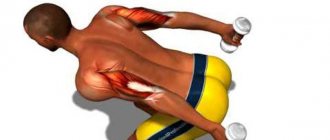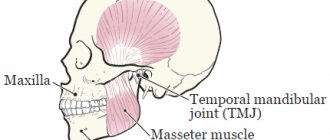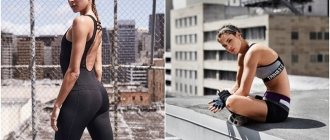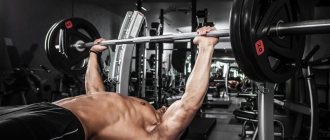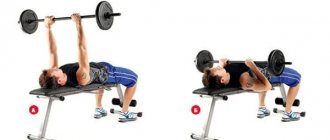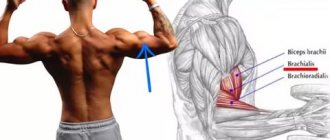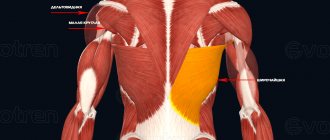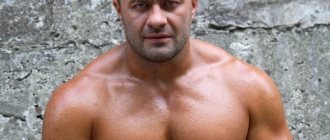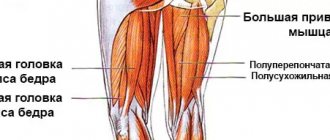The pectoral muscles (pectoral from the English pectoralis) are one of the main objects of training in strength sports, both for men and women. At first glance, they have a simple structure and function; up to 90% of the entire group is represented by the pectoralis major muscle. However, the thoracic region includes several components. Understanding their characteristics can make chest training as productive as possible.
The structure of the pectoral muscles
The entire area is represented by the following chest muscles:
- Large;
- Small;
- Serrated;
- Subclavian.
The latter is the smallest in volume in the group, therefore almost no attention is paid to it in sports.
If we take into account the anatomy of the pectoral muscles, the large one occupies almost the entire volume of the group. The structure of this pectoral muscle has a complex structure. The muscle fibers are directed in different directions, therefore, to work out the entire surface, a load is required from different angles. The pectoralis major starts from:
- medial part of the clavicle;
- anterior wall of the rectus abdominis muscle;
- anterior surface of the sternum and costal cartilages.
Attaches to the crest of the greater tubercle of the humerus and the edge of the deltoid. Structurally, it is the largest muscle of the chest, which covers the area in the form of a shield or solid plate.
The pectoralis minor muscle is the second largest in the group. It lies under the large one and starts from 2 to 5 costal teeth. Attached to the scapula (coracoid process).
The serratus pectoralis muscle is anatomically located away from the main group. Like the small one, it starts from the ribs and is attached to the shoulder blade.
The subclavian starts from the 1st rib (cartilaginous part) and is attached to the lower part of the clavicle.
In addition to the main group, the rib muscles are distinguished. They belong to infants and are divided into:
- superficial chest muscles;
- as well as the deep muscles of the chest.
They are responsible for inhalation and exhalation; they usually do not need additional training.
Respiratory muscles
External and internal intercostal muscles
There are two types of intercostal muscles: internal and external. The external ones are located under the superficial muscles, filling all the intercostal spaces of the anterior sections, in a more understandable language, these muscles are located directly on the ribs themselves in front, behind and between them. They are not located strictly vertically, but at an angle towards the chest. The external muscles begin from the lower edges of the upper rib and end at the upper edges of the underlying ribs. Main functions : raise the ribs, providing inspiration.
The internal intercostal muscles are also located between the ribs, but they are located inside the chest. In the area where cartilage is located, they are absent; there they are replaced by intercostal membranes. Main functions: lower the ribs and participate in the act of calm breathing. When breathing intensely, for example while running, other chest muscles are activated to exhale: the major and minor muscles, the trapezius, the neck and the abs.
Subcostal muscles
They are the deepest muscles of the chest, located below the internal intercostal muscles, attached to the ribs from below, on the inside. They differ from the intercostal muscles in that their bundles are thrown over one rib, reminiscent of basket weaving. Main functions: participate in the breathing process (exhalation). May raise the ribs during intense breathing.
Diaphragm
One of the unpaired muscles (does not have a pair). Separates the chest and abdominal cavities from each other, resembles a jellyfish in shape, begins along the entire circumference of the lower ribs, tapering towards the center and passes into the tendons. Main functions: during contraction, the diaphragm increases the volume of the chest and inhalation occurs. When relaxed, it takes on a convex shape (resembling a sphere). As a result, the chest shrinks and exhalation occurs. Also, involuntary jerky contractions lead to hiccups.
Basic functions of the chest muscles
In most cases, the functions of the pectoral muscles are duplicated, the entire array works as a single whole. Therefore, in sports, the entire group is linked by the function of the pectoralis major muscle, without isolating the rest separately.
Pectoralis major muscle:
- lowers his arms to his body from the top position;
- pronation (turning inward) of the hand;
- flexion of the arm (responsible for the clavicular part);
- assistance with inhalation and pulling the body (for example, while climbing a rope).
Pectoralis minor muscle:
- provides movement of the scapula;
- pulls the scapula up and down;
Also, the functions of the pectoralis minor muscle include assisting in breathing with fixed arms.
Serratus muscle:
Rotating and pushing the shoulder blade forward.
Subclavian muscle:
Provides downward movement of the collarbone.
In men and women, the chest muscles anatomically have almost no differences, with the exception of some features. The only visual difference is the mammary glands. And also in the anatomy of the pectoral muscles of men there is a predominance of fast muscle fibers. In women, the ratio is shifted towards slow fibers.
What exercises can you do to pump up your chest?
There is no one exercise that would give the same load to all parts of the pectoral muscles. Therefore, it is necessary to include a whole set of chest exercises in the training program and use various options for their implementation. This will allow you to carefully work out each area of the pectoral muscles, and ultimately pump up excellent breasts. Here is a complete list of exercises that load the chest:
- bench press lying on a horizontal and inclined bench (with different slopes);
- the same thing, but using dumbbells instead of a barbell;
- hummer bench press;
- raising dumbbells lying horizontally and at different angles;
- bringing hands together in a crossover from different positions;
- pullover using a dumbbell, barbell, or standing on an overhead block;
- raider thrust;
- different types of push-ups;
- parallel bars push-ups.
Of course, there is no need to perform all these movements in one workout. It is enough to include in it:
- one basic exercise – bench press (dumbbells) or push-ups (if necessary, with weights);
- two variations of the same exercise tilted up and down;
- one exercise each for extension and reduction;
- One exercise to expand the chest - pullover or raider row.
By changing exercises and options for performing them from workout to workout, you can comprehensively work out the entire volume of this muscle group.
The best chest exercises - research results
Not all chest exercises are equally effective - some of them allow you to pump up your chest faster. This was confirmed by research conducted at the Faculty of Physical Education and Sports at the University of Wisconsin (USA). The experiment involved 14 men aged 19-30 years, whose electrical activity of muscle tissue was measured during training.
Of the 9 popular chest exercises performed by the experiment participants, the greatest activity of the pectoral muscles was observed during the bench press. The crossover crossover showed only 2% less efficiency; the chest press while sitting in a machine was in third place with a result of 93%. The remaining exercises took lower places in the ranking, showing effectiveness from 79% to 61%.
This study confirms the importance of the bench press as a core exercise for pumping up the chest. Of course, it must be performed at every “chest” workout, but we should also not forget about the exercises that complement it. Only an integrated approach will allow you to pump up voluminous and strong breasts.
The best exercises for chest
- Bench press - works almost the entire shoulder girdle and arms.
- Bench press at an angle - focus on the upper chest.
- Dumbbell press (on a straight and incline bench) - duplicates the barbell press, but it loads the pecs to a greater extent.
- Lying dumbbell flyes.
- Pullover – loads the entire pectoral mass, especially the serratus muscle.
- Dips – focus on working the lower part of the pecs.
- Bringing the arms together in a crossover - working out the lower and inner parts.
How to pump up your breasts - theory
To pump up your chest, you need to pay attention to working out every part of this muscle group. To do this, you need to use as many different exercises and options for their implementation as possible. Not only the popular bench press and hand pinch, but also some exercises that are intended for other muscle groups have a good effect on chest growth:
- Dips are not only a triceps workout, but also an excellent workout for the pectoralis major muscles;
- the overhead pulley with a narrow grip works well not only the back, but also the sternal head of the pectoralis major;
- Lifting dumbbells in front of you trains, in addition to the deltoids, the clavicular head of the pectoralis major.
You can shift the load on different areas of the chest by changing the angle of the bench press:
- the upper head receives maximum load when tilted 30-45° forward;
- middle - on a bench without an incline;
- lower – when tilting 30-45° back (head higher than legs).
To pump up your chest, you need to take care not only of increasing muscle mass, but also of increasing the volume of the chest and improving its shape. This will help:
- a pullover with a barbell or dumbbell helps expand the chest, increasing its convexity and depth;
- bringing the arms together in a crossover stretches the muscle fibers, improves their blood supply, and helps create a clear relief of the pectoral muscles.
To pump up a wide chest, you need to increase the size of the serratus anterior muscles and increase the mass of the outer part of the pectoralis major, which is achieved by performing a bench press with a wide grip. A close-grip bench press, which works the central part of the pectoral muscles, will help pump up a high chest.
Benefits of training this muscle
We know that this muscle plays an important role in the function of the scapula. It keeps the scapula attached and moves across the rib cage.
. When the serratus muscle does not fit properly, it causes scapular flutter (when the scapula separates from the rib cage).
It is responsible for extension
, shoulder abduction and upward rotation of the scapula.
Most pressure movements, horizontal and vertical, involve the serratus anterior muscle.
aesthetic
Working out combined with low body fat gives you an uneven look under your chest and over your abs.
Better shoulder mobility
A strong serratus muscle allows the shoulder blades to move through the ribcage as intended through a fuller range of motion. If you don't use it, you will lose it and shoulder mobility may be limited over time.
Increased shoulder stability
The shoulder is a shallow ball-and-socket joint with the incredible ability to move in multiple directions. The serratus muscle plays an important role in holding the scapula against the rib cage to allow this mobility.
Core exercises[edit | edit code]
Beginner level
- Pelvic lift
- Twisting
- Medicine ball throw
- Plank
- Medicine ball throw up
- Extensor
- Lumberjack with medicine ball
- Climber steps
- Side throw
Advanced level
- Leg Raise
- Raising the body with emphasis on the elbows
- Good morning exercise on one leg with weights
- Saw
- Leg raise with ball
- Turkish Rise
- Rowing
- Raising the pelvis with support on one leg
- Rowing with push-ups
- Weighted crunch
- Windmill
- Moving with the ball
- Scorpion
- Turkish squats with kettlebell
- Knee lift
- Feet to the bar
Professional level
- Medicine ball push-ups
- corners
Bench press variations and their effect on load
The benefits of the bench press are not only its maximum effectiveness for the growth of the pectoral muscles, but also its versatility. Various variations of this chest exercise shift the emphasis to different areas of this muscle group, which allows you to thoroughly work out each of them. Let's look at how the bench angle, grip width, elbow position and other factors affect load distribution.
Bench angle
The bench press can be performed on a horizontal bench, on an incline with the head above the feet, and on an incline with the head below the feet. In each of these cases, the load is distributed as follows:
- Horizontal - the pectoral muscles are loaded evenly, the emphasis is on the central part of the chest.
- Bend forward (head up) - increases the load on the upper part of the pectoral muscles. In the range of inclination angles of 30-60°, the upper chest is well worked out, and at an inclination of more than 60°, part of the load is taken over by the front deltas.
- Bend back (head down) - maximum load falls on the lower part of the pectoral muscles. The greater the incline, the more the lower chest and triceps are loaded.
Using all three body position options when bench pressing, you can maximally work the upper, central and lower sections of the pectoral muscles.
Grip width
By changing the width of your hands on the barbell, you can redistribute the load between the center and edges of the pectoral muscles, as well as load the triceps and anterior deltoids:
- Classic grip (angle between the bar and forearm 90°) – the pectoral muscles are loaded evenly, there is no redistribution of the load on the triceps and anterior deltoid muscles.
- Wide grip (outer angle more than 90°) – the emphasis shifts to the outer edges of the chest, part of the load falls on the front of the deltoids. With a wide grip, the amplitude of the press decreases significantly.
- Narrow grip (outer angle less than 90°) - the load is redistributed to the central part of the pectoral muscles, closer to the sternum, the triceps are more heavily loaded. The range of movements does not decrease.
The wider the grip, the further to the side from the center of the chest the load moves and the deltoids are more strongly involved; the narrower it is, the more the central part of the pectoralis major muscles and triceps are loaded.
Elbow position
The degree of load on the pectoral muscles will depend on where the elbows are directed when bench pressing. The position of the elbows is determined by the angle between the body and the humerus;
- If this angle exceeds 45° (usually it is 60-80°; with larger values, discomfort and risk of injury increases), then the pectoral muscles are loaded to the maximum, and the anterior deltoids and triceps are unloaded.
- If the angle is less than 45°, then the load from the pectoral muscles is redistributed to the triceps and the front part of the deltoids. The closer the elbows are to the body, the less the chest is loaded.
If the goal is to pump up your chest, then you should give preference to the bench press option with your elbows apart, as this provides maximum load on the area being worked on.
Movement amplitude
The bench press with an incomplete (partial) amplitude allows you to press heavier weights. At the same time, with a reduced amplitude, the back, deltoids and triceps are less involved, and most of the load falls on the pectoral muscles. Therefore, if the goal is to pump up your chest, then it is better to choose a version of this exercise with incomplete amplitude and weight that ensures maximum muscle growth. If you train according to a shortened program and use the bench press to work your chest, shoulders and arms at the same time, then it is better to perform it with full amplitude.
Trajectory of movement
The barbell press can be carried out both in a straight line (straight up) and along an arcuate path with lifting above the head. In the second case, the range of motion and the load on the muscles are greater. But using a flat trajectory allows you to lift heavier weights, thereby accelerating muscle growth.
Direct and reverse grip
If your goal is to pump up your chest, then you need to press the barbell with an overhand grip, because in this case the target muscle group is loaded to the maximum. If you use a reverse grip, the load shifts to the triceps and anterior deltoids. This is due to the fact that in this position it is impossible to spread the elbows to the sides for optimal load distribution.
Back arch
A strong back arch when performing a barbell press reduces the range of motion and allows you to squeeze more weight. At the same time, due to a change in the angle of the torso, the load shifts to the lower part of the chest. However, with a strong deflection, the risk of injury increases, so “pressing from the bridge” is not recommended; only a small deflection is allowed.
Exercises for deep muscles: lesson one
July 15, 2011
How to improve posture during adolescence to prepare the body for subsequent stress? Start with the simplest exercises.
Supporting the body and coordinating the vertical position of the body is carried out by the so-called autochthonous muscles. If they are not sufficiently developed, posture is impaired and scoliosis develops. This problem is especially common in teenagers. Autochthonous muscles are very small; they connect the vertebrae and carry mainly a static load. They create a kind of axis of the body around which all other movements occur. A person cannot consciously control the tension and relaxation of these muscles - it is carried out reflexively
.
Autochthonous muscles are located very deep, and it is quite difficult to influence them. All conventional flexion and extension exercises of the torso usually only affect the muscles located closer to the surface of the body. How to do the simplest entry-level exercises
to strengthen the autochthonous muscles and abs, says Alexey Korochkin, researcher at the Department of Exercise Therapy and Sports Medicine of the Russian State Medical University.
If your physical fitness leaves much to be desired, start your warm-up with this set of exercises. The first two exercises are performed in a standing position on all fours
.
In the first, alternate the positions of the arched and arched back. Do it slowly at first, and then speed up the changes in position. The amplitude is small. Repeat 10-15 times. From the same position on all fours,
simultaneously
straighten Repeat 10-15 movements. The next two exercises are performed while lying on your stomach
.
Stretch your arms and legs forward, slightly spread your arms and legs to the sides. With a small amplitude, simultaneously lift your right arm and left leg off the ground, and then vice versa. Repeat 20 times. Lying on your stomach, put your legs together and put your hands behind your head. At the same time jerk your head up
, spread your elbows and lift your legs off the floor.
Do not try to lift your head and legs off the floor too high; perform the exercise with a comfortable amplitude. Repeat 10-15 times. Roll over onto your back
. Bend your knees, place your hands behind your head. With jerks, pull your left knee and right elbow towards each other, then your right knee and left elbow. Repeat 15 times. Illustration: Chris Leigh
Tags:
- Home workouts
- Back
- Charger
- Muscles
- Teenagers
- Exercises for deep muscles
2 comments • To leave a comment you must be an authorized user
- cazzaa I really liked it, BUT, it would be better for the girl to demonstrate the exercises in sports, tight-fitting clothes (not jeans). Convenient and comfortable. =)
- adept It’s just not clear: is it possible (is it necessary) to do this complex every day or can doing it every day cause harm?
